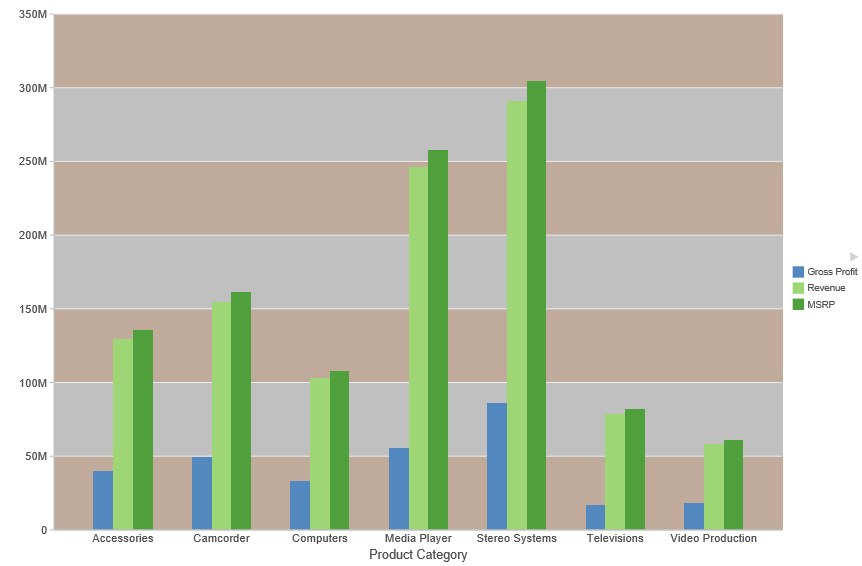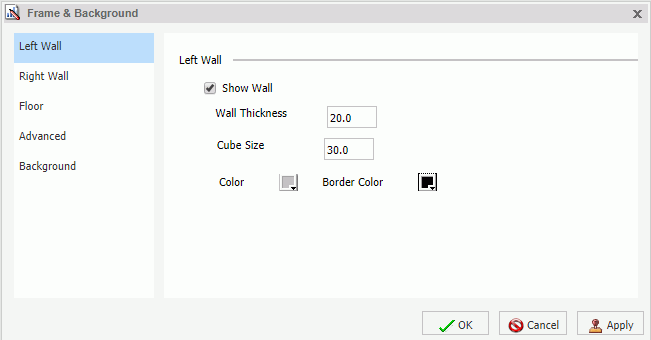Whether you access frame and background options from
the ribbon, or the shortcut menu, you are presented with the Frame
& Background dialog box of options for formatting the frame
and background of a chart. The Frame & Background dialog contains the
following tabs:
- Frame
- Frame Edge
- Background
The Frame & Background dialog box and pertinent tabs are
discussed in this section for the following types of charts:
- 2D Charts and 2D
Charts with 3D Effects (Frame and Frame Edge tabs)
- Pie Charts (Frame
and Frame Edge tabs)
- 3D Charts (Left Wall,
Right Wall, Floor, and Advanced tabs)
Note: The options in the Frame tab vary based on the chart
type selected.
Use the Frame tab for 2D charts and 2D charts with 3D effects
to set a frame depth angle and depth radius, select a fill for a
frame, and set a shadow for a frame for these types of charts.
The Frame tab for 2D charts and 2D charts with 3D effects contains
the following options:
- Depth Angle. Enter
the angle from the front of the chart to the back where the chart
risers and frames are drawn. You can set the depth angle from zero
to 180 degrees, but it must be used along with Depth Radius.
The depth angle in 3D charts can only be changed when using the HTML, PDF, PowerPoint, and Excel output formats.
- Depth Radius. Enter
how far out the extruded frame will be extended. Small values, such
as zero, produce very narrow charts. Large values, the maximum being
100, produce thicker charts.
Fill
- No fill. (Default).
Select this option to keep the legend colorless.
- Solid fill. Select
this option to display the Color and Transparency options.
- Color. Click
this icon to open the Color dialog box, where you can select a color
for a frame.
- Transparency. Move
the slider to make the frame opaque (0%) or transparent (100%).
The default is 0%.
- Gradient fill. Select
this option to display the direction of the gradient, the color
pattern of the gradient, and the degrees of transparency for the
two colors that make up the gradient. A gradient is a smooth color
transition or blending of one color to another. The number of colors
to use in a gradient is defined by the stop or pin elements.
- Direction. Select
from this drop-down menu to set the direction of the gradient fill.
For example, Gradient right or Gradient left.
Gradient style
- Color Pattern. Select
the color pattern for the data series. The color pattern option
on the left is an AB wash that uses two colors in the pattern color1
- color2, for example, red-green. The color pattern option on the
right is an ABA wash that uses two colors in the pattern color1
- color2 - color1, for example, red-green-red.
- First Color. Click
this icon to open the Color dialog box, where you can select a color
for the first color.
- Second Color. Click
this icon to open the Color dialog box, where you can select a color
for the second color.
Shadow
- Show Shadow. Select
this option to set a shadow.
Use the Frame Edge tab for 2D charts and 2D charts with 3D effects
to set a frame depth angle and depth radius, select a fill for a
frame, and set a shadow for a frame for these types of charts.
The Frame Edge tab for 2D charts and 2D charts with 3D effects
contains the following options:
- Automatically Shade Frame Edge. Select
this option to automatically shade the frame edge. Clear this option
to enable the Side Frame and Bottom Frame options.
Side Frame
Bottom Frame
Use the Frame tab for pie charts to set pie depth and tilt, select
a fill and color for a pie frame, and set a shadow for the frame.
Note: This is only available for pie charts in HTML format.
The Frame tab is shown in the following image.
The Frame tab for pie charts contains the following options:
- Pie Depth. Set
the depth of the edge of a pie chart. You can select a value from
zero to 100 to set the thickness of an edge.
- Pie Tilt. Set
the tilt of the pie chart. The smaller the value you add, the flatter
the pie chart appears. The larger the value you add, more of the
pie edge appears.
Fill
- No fill. (Default).
Results in no color added to the edge of the pie.
- Solid fill. Select
this option to display the Color and Transparency options.
- Color. Click
this icon to open the Color dialog box, where you can select a color
for the frame.
- Transparency. Move
the slider to make the fill opaque (0%) or transparent (100%). The
default is 0%.
- Gradient fill. Select
this option to display the direction of the gradient, the color
pattern of the gradient, and the degrees of transparency for the
two colors that make up the gradient. A gradient is a smooth color
transition or blending of one color to another. The number of colors
to use in a gradient is defined by the stop or pin elements.
- Direction. Select
from this drop-down menu to set the direction of the gradient fill.
For example, Gradient right or Gradient left.
- Gradient Style
- Color Pattern. Select
the color pattern for the data series. The color pattern option
on the left is an AB wash that uses two colors in the pattern color1
- color2, for example, red-green. The color pattern option on the
right is an ABA wash that uses two colors in the pattern color1
- color2 - color1, for example, red-green-red.
- First Color. Click
this icon to open the Color dialog box, where you can select a color
for the first color.
- Second Color. Click
this icon to open the Color dialog box, where you can select a color
for the second color.
Shadow
- Show Shadow. Select
this option to set a shadow around the frame.
Use the Frame Edge tab for pie charts to set the edge of a pie
frame.
The Frame Edge tab for pie charts contains the following options:
- Automatically Shade Frame Edge. Select
this option to automatically shade the frame edge. Clear this option
to enable the Side Frame and Bottom Frame options.
- Show Color. Select
this option to show the color of the side frame.
- Color. Click
this icon to open the Color dialog box, where you can select a color
for side frame.
- Show Border Color. Select
this option to show the color of the border of the side frame.
- Border Color. Click
this icon to open the Color dialog box, where you can select a color
for the border of the side frame.
Bottom Frame
- Show Color. Select
this option to show the color of the bottom frame.
- Color. Click
this icon to open the Color dialog box, where you can select a color
for the bottom frame.
- Show Border Color. Select
this option to show the color of the bottom frame.
- Border Color. Click
this icon to open the Color dialog box, where you can select a color
for the border of the bottom frame.
Use Wall and Floor tabs to set the walls and floor of a 3D chart.
The Left Wall tab is shown in the following image.
These Wall and Floor tabs contain the following options:
- Show Wall or Show Floor. Select
this option to show the wall or floor (depending on the tab) of
the 3D chart.
- Wall Thickness. Specify
the thickness of the wall or floor.
- Cube Size. Specify
the cube size of the wall or floor.
- Color. Click
this icon to open the Color dialog box, where you can select a color
for the wall or floor.
- Border Color. Click
this icon to open the Color dialog box, where you can select a color
for the border of the wall or floor.
- Show Wall (Left Wall). Select
this option to show the left wall.
- Show Wall (Right Wall). Select
this option to show the right wall.
- Show Floor. Select
this option to show the floor.
Use the Advanced tab for 3D charts to modify additional properties
for 3D frames.
The Advanced tab contains the following options:
- Viewing Angles. Select
from a drop-down menu of viewing angles for three-dimensional charts.
For example, Standard or Group View.
- Isometric Projection. Select
this option to ignore perspective distortion in a project graph
cube from an isometric view.
- Proportional Cube. Select
this option to define the axis size proportional to the number of
series or groups.
- Automatic shading of walls. Select
this option to shade chart walls.
- Automatically Shade Frame Edge. Select
this option to automatically shade the frame edge.
- 3D Zoom Factor. Enter
a value in the text box to set the global scaling factor for zooming
in and out in a 3D chart. Smaller values zoom out and produce a
smaller display of the chart within a frame. Larger values zoom
in and produce a larger display of the chart within a frame.
- Pan Horizontally. Enter
a value in the text box to pan a 3D chart in the horizontal direction.
Smaller values move the frame of the chart to the left. Larger values
move the frame of the chart to the right.
- Pan Vertically. Enter
a value in the text box to pan a 3D chart in the vertical direction.
Smaller values move the frame of the chart upward. Larger values move
the frame of the chart downward.
Use the Background tab to set and customize a border for a chart.
The Background tab contains the following options:
- Show Border Color. Select
this option to show the color of the border.
- Border Color. Click
this icon to open the Color dialog box, where you can select a color
for the border.
- Solid fill. Select
this option to display the Color and Transparency options.
- Color. Click
this icon to open the Color dialog box, where you can select a color
for the frame.
- Transparency. Move
the slider to make the background opaque (0%) or transparent (100%).
The default is 0%.
- Gradient fill. Select
this option to display the direction of the gradient, the color
pattern of the gradient, and the degrees of transparency for the
two colors that make up the gradient. A gradient is a smooth color
transition or blending of one color to another. The number of colors
to use in a gradient is defined by the stop or pin elements.
- Direction. Select
from this drop-down menu to set the direction of the gradient fill.
For example, Gradient right or Radial.
Gradient Style
- Color Pattern. Select
the color pattern for the data series. The color pattern option
on the left is an AB wash that uses two colors in the pattern color1
- color2, for example, red-green. The color pattern option on the
right is an ABA wash that uses two colors in the pattern color1
- color2 - color1, for example, red-green-red.
- First Color. Click
this icon to open the Color dialog box, where you can select a color
for the first color.
- Second Color. Click
this icon to open the Color dialog box, where you can select a color
for the second color.
For instructions on how to open this dialog box, see the procedures
in Using Frame
and Background Properties.


